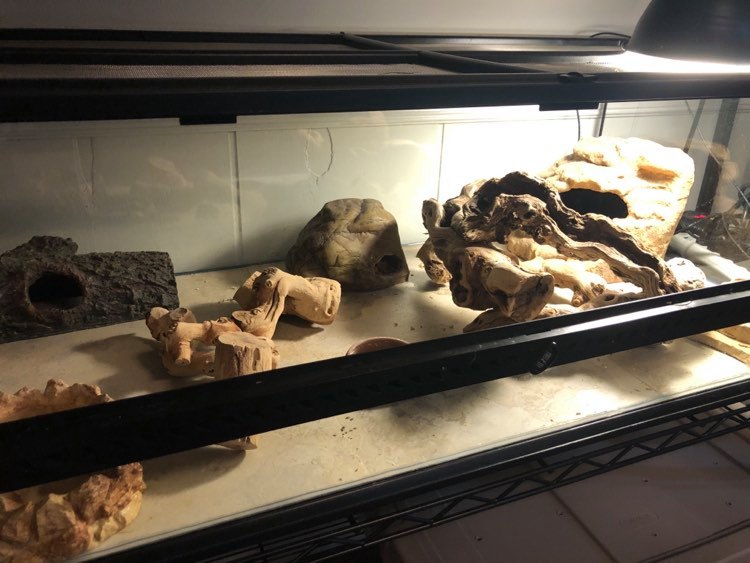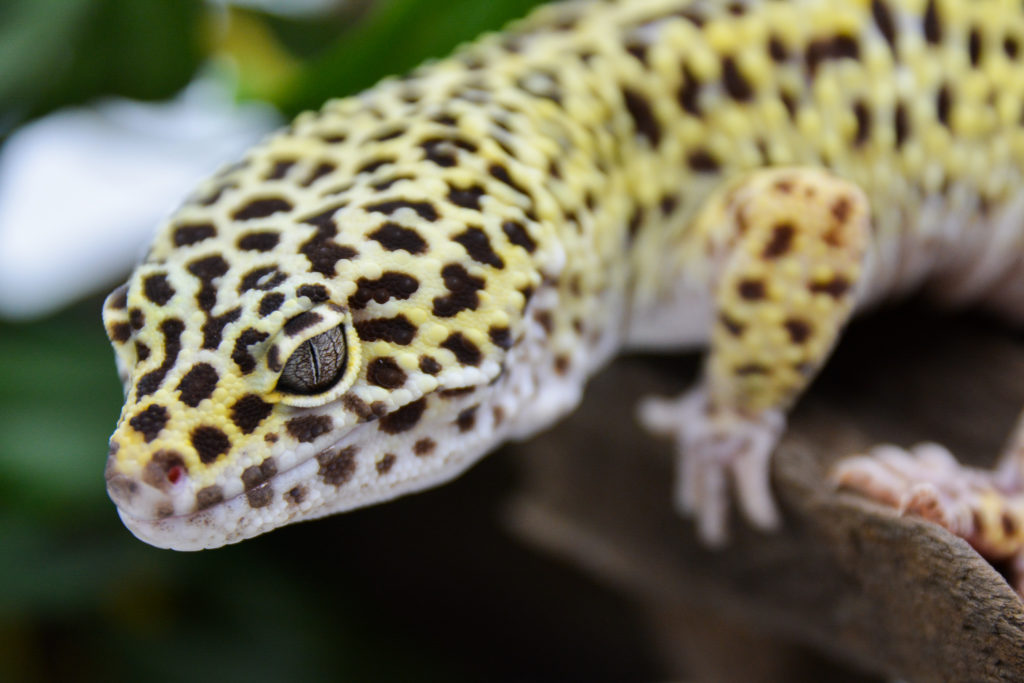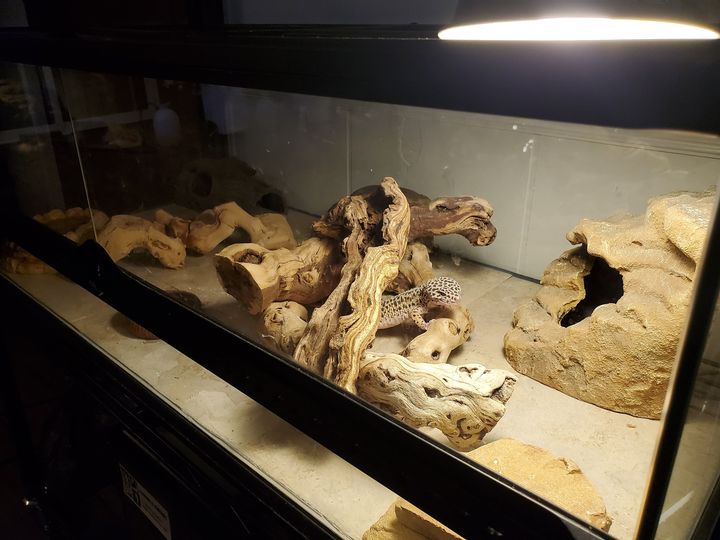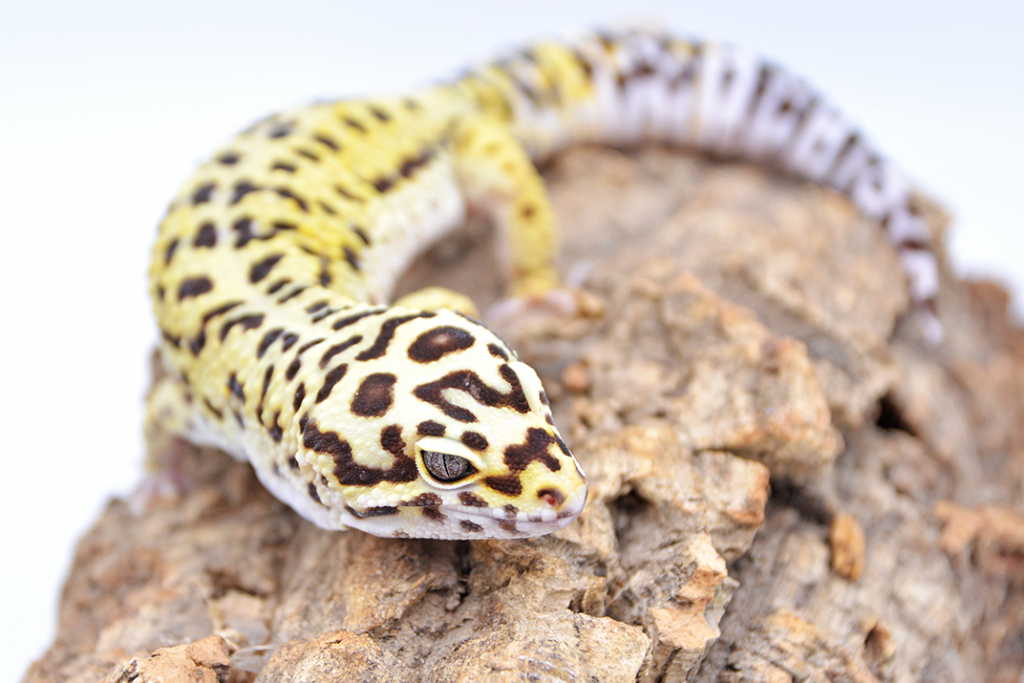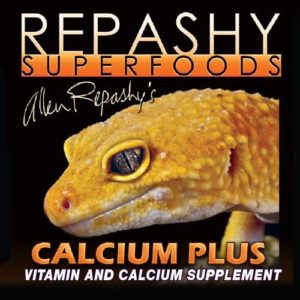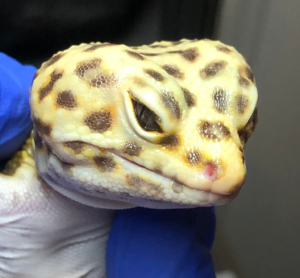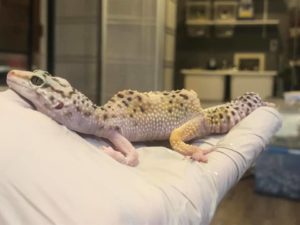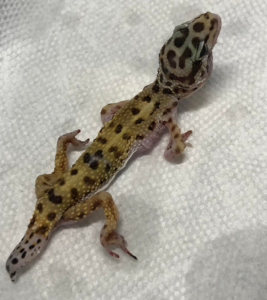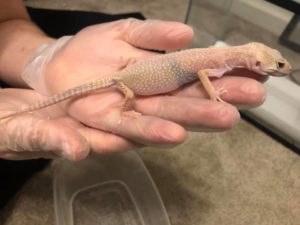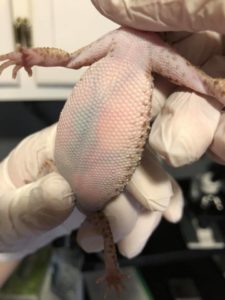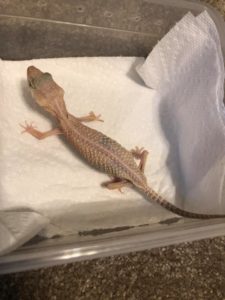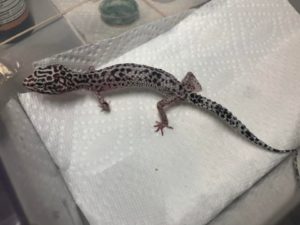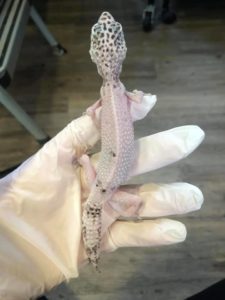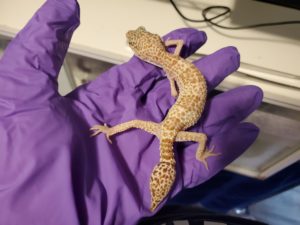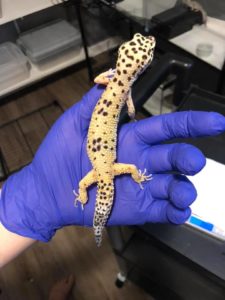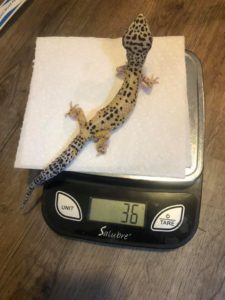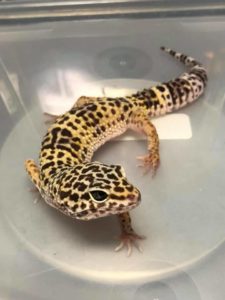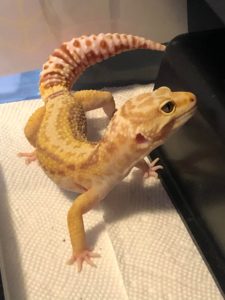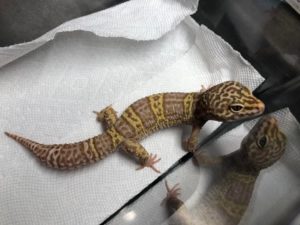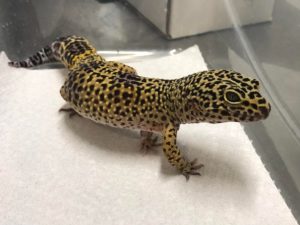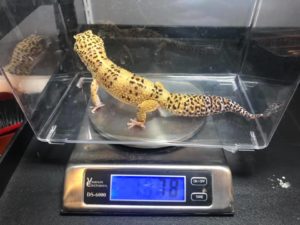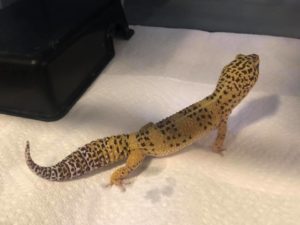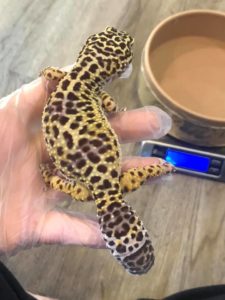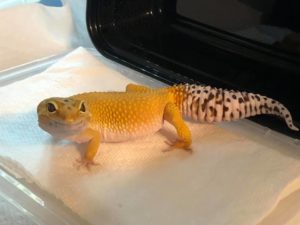Hypovitaminosis A: When leopard geckos don’t get enough vitamin A, they can develop a condition where mucosal membranes keratinize and form a dense, waxy cellular material. This usually deposits over the eyes and around the hemipenal area for males. In advanced cases, this can spread to the mouth when material from the eyes travels through the tear ducts. It will cause blindness and pain, and animals with hypovitaminosis A should be brought to the veterinarian for potential debridement, supplements, and nutritional support if it has not been eating. They also may need to be treated for secondary infections, and some animals may have permanent corneal scarring and blindness if the condition is too severe. Do not try to dose human vitamin A supplements; if given too much vitamin A, reptiles can develop skin sloughing issues and it can be just as serious. You MUST give a regular multivitamin supplement in order to prevent hypovitaminosis A, as the only captive feeder insects that contain any vitamin A are silkworms.
Hypovitaminosis E: In recent years, Vitamin E deficiencies are being observed more frequently in leopard geckos. We have seen a strong correlation between super snow morph leopard geckos and hypovitaminosis E, so there is some thought that inbreeding may be causing these geckos to be genetically predisposed to it. Vitamin E deficiencies cause fat tissues to become necrotic, leading to inflammation in the muscle. The primary symptom we see is bilaterally enlarged masseter muscles (behind the ears), though we have also seen masses throughout the body. We have received three leopard geckos with this condition, one of which we took in for a biopsy of these swellings. The biopsy showed 100% muscle tissue, no infection or parasitic cause. Treatment includes supplemental vitamin E, selenium, and possibly an anti-inflammatory for swelling or pain. The prognosis for advanced cases is grave, but mild and moderate cases can see the swelling regress or remain stable.
Parasites: Leopard geckos can carry many different types of parasites, including pinworms, coccidia, spirochetes, and protozoans. It is common for leopard geckos to have a small level of parasites, this is normal for their gut flora. However, when a leopard gecko is sick or stressed, the parasites can take over and cause diarrhea, weight loss, and anorexia. This can become serious, so bring a fecal to your veterinarian if your gecko is exhibiting the above signs.
Eye Infections: Leopard geckos can get eye infections, but these are usually secondary to stuck shed or vitamin A deficiencies. An eye infection will typically have watery, purulent material, and the conjunctiva may be red or swollen. To treat this, bring your gecko to an exotic veterinarian so the vet can flush the eye and prescribe ophthalmic or systemic antibiotics. Make sure to prevent this by keeping a clean, dry enclosure.
Metabolic Bone Disease: Captive lizards need supplemental sources of calcium, or else they will develop MBD. This disease is also termed “nutritional secondary hyperparathyroidism.” We see this frequently in surrendered animals, and in severe cases the animals can have permanent deformities or die. When a gecko doesn’t have enough calcium, its body will start to pull calcium from its bones to support heart and organ function. Eventually, they get so weak they cannot walk properly, stand, or eat. The first signs of MBD include curved legs and weak jawbones, and this can advance to spinal kinks, bone fractures, and tremors as the gecko loses more calcium from the bones. Always see a veterinarian to get an exam on your animal’s condition; most of the time, your vet will give you a prescription liquid calcium to give orally, and potentially syringe-feeding formula if your gecko is not able to eat on its own. More severe cases may require additional medications and diagnostics, such as x-rays or bloodwork. You should also correct your diet to include calcium-dusted insects and gut load your insects with a calcium-rich food. Geckos with MBD should be provided UVB lights to help strengthen their bones and prevent resurgence after recovery.
Mouth Rot: Mouth rot, or ulcerative stomatitis, is a condition where the mouth develops a bacterial infection. This can be due to a dirty water source or dirty enclosure, a wound in the mouth that becomes infected, or stuck shed around the face. Mouth rot can quickly become serious, as it is painful and will cause the gecko to not want to eat. You should see a veterinarian to clean out the mouth and start an antibiotic regimen. Make sure to always maintain a clean environment and remove any stuck shed.
Dystocia: This is also known as “egg binding” and it is when an animal cannot lay their eggs properly. If your female gecko has a distended abdomen and is straining without any success laying eggs, see a veterinarian immediately. Females will develop infertile eggs even without a male. Dystocia is life-threatening and can be exacerbated by low calcium levels. Your veterinarian may try oxytocin and calcium injections to encourage contractions, but if this isn’t successful then a surgery may be required.
Dysecdysis/Retained Shed: Pet leopard geckos often have issues with stuck shed, as they need a humid hide in order to shed properly. A gecko should always finish shedding in 24 hours. If they have retained shed, soak the gecko in a shallow bin of warm water and gently remove the shed with a cotton swab. If retained shed is left on the gecko’s toes, it can constrict around the toes and cause them to become infected and necrotic. Retained shed can also occur in the gecko’s eyes, which can cause blindness, anorexia, and infection. If your gecko is having chronic issues with retained shed, or if there is infection and necrosis, see a veterinarian and immediately correct your humidity issues by providing a humid hide. A lack of vitamin A can also lead to skin issues, so make sure to provide a multivitamin.
Cryptosporidium: This is caused by a parasite and is commonly called “stick tail” in the pet keeping hobby. Cryptosporidium varanii infects mostly geckos, while Cryptosporidium serpentis infects mostly snakes; however, both species of crypto have been found in both lizards and snakes. Cryptosporidium is a severe, contagious, and often fatal disease with no cure. The most common sign is a “stick tail,” or completely emaciated tail with no fat coverage. They will usually be generally emaciated and may be anorexic. To diagnose crypto, ask your vet to send out a PCR of a fresh fecal. If your gecko is positive for crypto and is severely affected, your vet will likely recommend euthanasia. Some geckos can carry cryptosporidium without any symptoms, and some only have moderate symptoms. One medication called paromomycin can help alleviate symptoms of cryptosporidium, but it is not a cure. If your gecko tests positive for cryptosporidium and you do not euthanize, this gecko should be kept in strict quarantine for the rest of its life. It should be kept away from other reptiles and have its own feeding and cleaning equipment. We also recommend using disposable gloves when working with crypto-positive animals. Cryptosporidium eggs are notoriously hard to kill; the only disinfectant that is readily available to pet owners is 3-6% hydrogen peroxide. If you have an animal test positive, we recommend disposing of all equipment; if not, soak all of the materials in 6% hydrogen peroxide for at least 20 minutes.
Hepatic lipidosis: This is the term for “fatty liver disease,” and is a common malady in overweight reptiles. This is common in geckos fed high-fat diets, such as waxworms, superworms, and mealworms. Superworms and mealworms can definitely be used as a part of a balanced diet, but waxworms are especially high in fat and should only be fed sparingly. If a gecko gets too much fat in the diet, the body cannot process it all and fat starts to deposit in the liver. In advanced cases, this causes anorexia, fluid buildup in the body, regurgitation, and death. See a veterinarian if you are concerned your gecko has hepatic lipidosis. They will likely recommend a diet change and feeding consistent amounts of low-fat foods.
Prolapse: Cloacal prolapses can happen in both male and female geckos, but male geckos can also get hemipenal prolapses. A prolapse is an emergency that should see a veterinarian immediately. If it is recent, sometimes the vet can push the prolapsed tissue back in and place a temporary suture, but advanced prolapses can become infected and necrotic. Some will need amputated.
Follicular stasis: Follicular stasis is a reproductive disease that occurs in female leopard geckos. It may be more common in geckos that are overweight, as it is common for female reptiles to put extra fat and protein toward egg development. Follicular stasis presents as a bloated, swollen abdomen and anorexia. The gecko may start to lose weight in the other areas of the body, such as the tail. This is also a veterinary emergency, and your gecko will need surgery to remove the follicles. Follicles are the beginning of reptile eggs, and are not yet calcified. If the follicles are not removed, they can become infected or burst inside the body, causing a condition called yolk coelomitis. This condition can become deadly, so seek veterinary assistance immediately.
Gout: Gout is an accumulation of uric acid crystals either in the joints (articular gout) or internal organs (visceral gout). Gout is not common in geckos, but it can be seen in geckos with underlying kidney issues or previous poor husbandry. Gout can be caused by multiple pathways, including a genetic predisposition, chronic dehydration, kidney disease, or extremely high-protein diets. If it is caught early enough, it can be treated, though the treatment is often lifelong. However, animals with severe gout may be euthanized, especially if it is affecting internal organs or if the animal is experiencing severe pain or mobility issues. Signs of articular gout can include bulbous swelling of the joints; mostly the fingers/toes, ankles, and wrists. These swellings are often asymmetrical. Your vet may do several diagnostics for gout, such as radiographs, bloodwork, or a fine needle aspirate from the affected joint. Treatment includes an oral medication called allopurinol, as well as potentially pain medication.
Hemipenal Impaction: Male leopard geckos can have hemipenal impaction, or “casts,” usually secondary to hypovitaminosis A or stuck shed. Mild casts can usually be gently massaged out of the hemipenal area, but severe casts should see a veterinarian for possible sedation and/or debridement. Prevent this by offering a multivitamin, using a humid hide, and keeping the enclosure clean.
Impaction: Leopard geckos kept on particulate substrates, such as sand, calcium sand, walnut, or mulch, can develop impaction if they eat the substrate. If your gecko is kept on a particulate substrate and is anorexic, losing weight, but has a swollen, bloated abdomen, see your veterinarian for x-rays and treatment. We do not recommend using any sort of particulate substrate for beginner keepers. Advanced reptile keepers have been able to successfully keep leopard geckos in bioactive enclosures with appropriate sand/soil substrates and heating sources, but this is much more complex than a simple sand tank. A healthy leopard gecko with proper husbandry can usually pass small amounts of sand/soil, but a gecko with poor nutrition, husbandry, or too low basking temperature can have issues with impaction.

